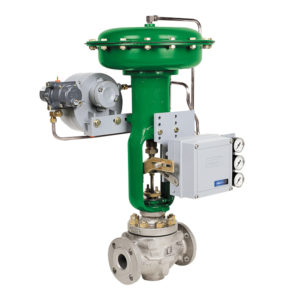What is the Difference Between Air to Close (ATC) and Air to Open (ATO) Valves?
The main difference between air to open (ATO) and air to close (ATC) control valves is the way they respond to their control signal. ATO valves, without any air pressure to the actuator, are normally closed, meaning that they require air pressure to open. ATC valves, without any air pressure to the actuator, are normally open, meaning that they require air pressure to close.
If a plant’s air supply system or control system loses power, the operators are unable to control the process in a safe and stable manner, which can be very dangerous, causing catastrophic damage and injury. In such power failure situations it is essential for the control system to go to a “fail safe” mode and the valves be forced to go to their fail-safe position.
The fail-safe position of a valve is the position that the valve will move to if the air pressure fails. For ATO valves, the fail-safe position is closed. This means that if the air pressure fails, the ATO valve will close and prevent the flow of fluid. For ATC valves, the fail-safe position is open. This means that if the air pressure fails, the ATC valve will open and allow the flow of fluid.
Check out this table which summarizes the differences between ATO and ATC valves:
| Feature | Air to Open Valve (ATO) | Air to Close Valve (ATC) |
| Normal Unpowered Position | Closed | Open |
| Requires Air Pressure to | Open | Close |
| Fail-safe Position | Closed | Open |
ATO valves are often used in applications where it is important to prevent the flow of fluid in the event of a power failure. For example, ATO valves are often used in fired boiler fuel systems. If the power fails, the ATO valves will close and prevent the flow of fuel, which will shut down the boiler and keep it from running out of control. Better to safely shutdown the boiler than to have it run out of control and cause a catastrophic event. Another example is steam to a steam turbine; not controlling or going fully open will cause catastrophic damage to the turbine, better to close the valve, shut off the steam supply, and shut down the turbine.
ATC valves are often used in applications where it is important to allow the flow of fluid in the event of a power failure. For example, ATC valves are often used in boilers on the feedwater supply; running a boiler empty of water without shutting off the fuel will cause an explosion. If the power fails, the ATC valves will open and allow the flow of water to the boiler, which will prevent it from running empty and overheating.
Here are some common applications for both ATO and ATC valves:
Air to Open (ATO) valves:
- Fired Boiler Fuel Valves
- Steam Turbines
- Chemical injection systems
- Medical gas systems
Air to Close (ATC) valves:
- Boiler Feedwater System
- Steam generators
- Air compressor unloading systems
The proper fail-safe position of every valve is determined during the design and safety review of every process-by-process design engineers and safety specialists.
The fail-safe position of a valve is important for safety reasons. In the event of a power failure, it is important to ensure that the valve will move to a position that will prevent damage or injury.
In addition to the application consider the following when choosing between ATC and ATO valves:
- Cost: ATO valves are typically more expensive than ATC valves.
- Complexity: ATO valves are typically more complex than ATC valves.
- Maintenance: ATO valves typically require more maintenance than ATC valves.
The best type of valve for a particular application will depend on the specific requirements of the application. If you have questions about ATC and ATO valves, contact the experts at Automation Service.

